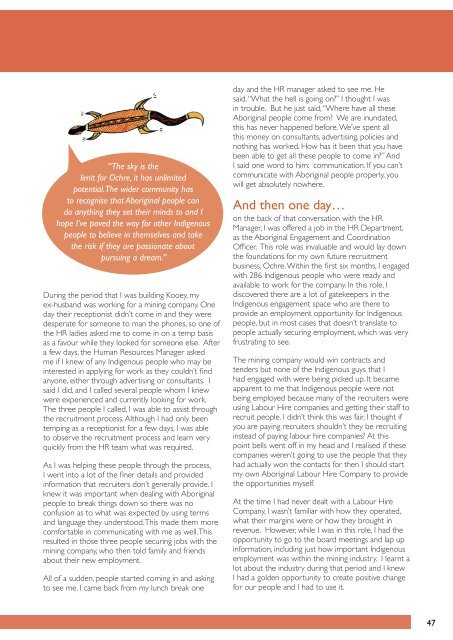INDIGENOUS STORYBOOK
bbj6MXa
bbj6MXa
Create successful ePaper yourself
Turn your PDF publications into a flip-book with our unique Google optimized e-Paper software.
“The sky is the<br />
limit for Ochre, it has unlimited<br />
potential. The wider community has<br />
to recognise that Aboriginal people can<br />
do anything they set their minds to and I<br />
hope I’ve paved the way for other Indigenous<br />
people to believe in themselves and take<br />
the risk if they are passionate about<br />
pursuing a dream.”<br />
During the period that I was building Kooey, my<br />
ex-husband was working for a mining company. One<br />
day their receptionist didn’t come in and they were<br />
desperate for someone to man the phones, so one of<br />
the HR ladies asked me to come in on a temp basis<br />
as a favour while they looked for someone else. After<br />
a few days, the Human Resources Manager asked<br />
me if I knew of any Indigenous people who may be<br />
interested in applying for work as they couldn’t find<br />
anyone, either through advertising or consultants. I<br />
said I did, and I called several people whom I knew<br />
were experienced and currently looking for work.<br />
The three people I called, I was able to assist through<br />
the recruitment process. Although I had only been<br />
temping as a receptionist for a few days, I was able<br />
to observe the recruitment process and learn very<br />
quickly from the HR team what was required.<br />
As I was helping these people through the process,<br />
I went into a lot of the finer details and provided<br />
information that recruiters don’t generally provide. I<br />
knew it was important when dealing with Aboriginal<br />
people to break things down so there was no<br />
confusion as to what was expected by using terms<br />
and language they understood. This made them more<br />
comfortable in communicating with me as well. This<br />
resulted in those three people securing jobs with the<br />
mining company, who then told family and friends<br />
about their new employment.<br />
All of a sudden, people started coming in and asking<br />
to see me. I came back from my lunch break one<br />
day and the HR manager asked to see me. He<br />
said, “What the hell is going on?” I thought I was<br />
in trouble. But he just said, “Where have all these<br />
Aboriginal people come from? We are inundated,<br />
this has never happened before. We’ve spent all<br />
this money on consultants, advertising, policies and<br />
nothing has worked. How has it been that you have<br />
been able to get all these people to come in?” And<br />
I said one word to him: communication. If you can’t<br />
communicate with Aboriginal people properly, you<br />
will get absolutely nowhere.<br />
And then one day…<br />
on the back of that conversation with the HR<br />
Manager, I was offered a job in the HR Department,<br />
as the Aboriginal Engagement and Coordination<br />
Officer. This role was invaluable and would lay down<br />
the foundations for my own future recruitment<br />
business, Ochre. Within the first six months, I engaged<br />
with 286 Indigenous people who were ready and<br />
available to work for the company. In this role, I<br />
discovered there are a lot of gatekeepers in the<br />
Indigenous engagement space who are there to<br />
provide an employment opportunity for Indigenous<br />
people, but in most cases that doesn’t translate to<br />
people actually securing employment, which was very<br />
frustrating to see.<br />
The mining company would win contracts and<br />
tenders but none of the Indigenous guys that I<br />
had engaged with were being picked up. It became<br />
apparent to me that Indigenous people were not<br />
being employed because many of the recruiters were<br />
using Labour Hire companies and getting their staff to<br />
recruit people. I didn’t think this was fair, I thought if<br />
you are paying recruiters shouldn’t they be recruiting<br />
instead of paying labour hire companies? At this<br />
point bells went off in my head and I realised if these<br />
companies weren’t going to use the people that they<br />
had actually won the contacts for then I should start<br />
my own Aboriginal Labour Hire Company to provide<br />
the opportunities myself.<br />
At the time I had never dealt with a Labour Hire<br />
Company, I wasn’t familiar with how they operated,<br />
what their margins were or how they brought in<br />
revenue. However, while I was in this role, I had the<br />
opportunity to go to the board meetings and lap up<br />
information, including just how important Indigenous<br />
employment was within the mining industry. I learnt a<br />
lot about the industry during that period and I knew<br />
I had a golden opportunity to create positive change<br />
for our people and I had to use it.<br />
47


